Abstract
The advancements in the 4th-generation synchrotron radiation light sources, characterized by their enhanced coherence and brightness, have led to more stringent requirements for the surface quality of X-ray mirrors used in beamlines. This poses a significant challenge to the metrology of X-ray mirrors. This research work focuses on high-precision measurement techniques for X-ray mirrors. The algorithmic principles of various stitching methods were introduced in detail, and a custom-built stitching measurement system was demonstrated. The system was used to perform a stitching measurement on an elliptical X-ray mirror, and the results showed high consistency with the data provided by JTEC. This verifies the effectiveness of the stitching interferometry method and the high measurement capability of our system.
1. Introduction
The continuous progress in synchrotron radiation sources and free-electron lasers is leading to steadily improving beam quality. In order to maintain the performance of high-quality beams during transmission, strict requirements need to be imposed on the surface error of X-ray mirrors used in beamlines. At present, the surface shape accuracy requirements for X-ray mirrors in fourth-generation light sources are as high as 1 nm (PV) and 50 nrad (RMS), with a roughness not exceeding 0.1 nm (RMS) []. This poses considerable challenges to the processing and metrology of X-ray mirrors, and the bottleneck of processing technology largely depends on the level of metrology technology. On the one hand, during the precise polishing of X-ray mirrors, accurate residual surface error data must be provided to guide the process parameters for the next round. On the other hand, the acceptance inspection and assembly adjustment of high-precision mirrors also inevitably rely on high-precision surface metrology. Therefore, research on high-precision X-ray mirror measurement technology is of significant importance.
X-ray mirrors differ from ordinary mirrors in that they are characterized by large size, high steepness, and complex surface shapes, making conventional surface measurement techniques ineffective. At present, there are two mainstream measurement schemes for X-ray mirrors, namely, the scanning deflection technique based on slope measurement and the stitching interferometry based on height measurement. The scanning deflection technique based on slope measurement mainly includes two technical routes: the long trace profiler (LTP) [,,] and the nanometer optical component measuring machine (NOM) [,,]. Both of them possess efficient measurement capabilities and a measurement accuracy better than 100 nrad. Stitching interferometry based on height measurement enables the acquisition of a mirror’s two-dimensional shape profile with sub-millimeter lateral resolution. This provides comprehensive height data for mirror acceptance inspection and offline installation, and also serves as an ideal feedback format for deterministic mirror processing.
Since its application in the field of synchrotron radiation in the early 21th century, stitching interferometry has made considerable progress through the continuous efforts of institutions such as Osaka University [,,,,,,], the European Synchrotron Radiation Facility [,,,], Brookhaven National Laboratory [,,,,,], Tongji University [,,], Diamond Light Source [] and so on. According to the different ways of obtaining the stitching angle, it can mainly be divided into two categories: calculating the stitching angle based on the overlapping area [,,] and measuring the stitching angle with auxiliary equipment [,,]. Both types of strategies have their own unique strengths and shortcomings. The method of calculating the stitching angle based on the overlapping area requires a simple device and the data processing process is relatively simple, but it is prone to the cumulative effect of stitching angle errors. The method of measuring the stitching angle with auxiliary equipment can overcome the cumulative effect of the stitching angle errors, but the complexity of the equipment is quite high and the data processing process is relatively complicated. Both of these two types of schemes have been widely applied in the field of synchrotron radiation X-ray mirror metrology.
To enhance the measurement capability for synchrotron radiation mirrors, the authors conducted a study on the stitching interferometry. This paper introduces a measurement system constructed by the authors, which mainly consists of a hardware measurement platform for scanning various local areas of the mirror surface and a software for processing interferometric shape data. In this paper, the principle of stitching interferometry is first introduced, then the developed measurement system is presented, and finally, the results of measuring an elliptical X-ray mirror using this system are provided. The main innovations of this work lie in the following two aspects. First, by implementing a series of measures to maximize temperature stability and minimize vibration levels in the environment, a highly stable measurement platform has been established. Based on this platform, we achieved a single sub-aperture repeatability of 0.084 nm and a stitching measurement repeatability of 0.26 nm. Second, this paper developed a new interferometric data processing software. This software, based on the Qt development platform, is programmed in C++ and integrates environmental and system evaluation functions, as well as data stitching capabilities. Together with the stitching interferometry hardware platform, it forms a complete metrology system, significantly improving measurement efficiency and ease of operation.
2. Principles and Methods
2.1. Calculation Principles of the Stitching Angle
Due to the unique characteristics of synchrotron radiation mirrors, interferometers typically cannot capture the complete surface profile of the mirror under test in a single measurement. Inspired by the sub-aperture stitching approach, researchers first use an interferometer to acquire local surface shape information of the mirror. They then determine the ideal positional relationships among these multiple local surfaces, and finally stitch and merge them to reconstruct the full surface data of the mirror. In this process, the calculation of the sub-aperture stitching angle is a crucial link. As shown in Figure 1, the calculation of the stitching angle mainly relies on the redundant data and in the overlapping areas between sub-apertures. Based on the consistency of the data in the overlapping areas of different sub-apertures, the attitude adjustment parameters , and of the sub-apertures can be obtained.
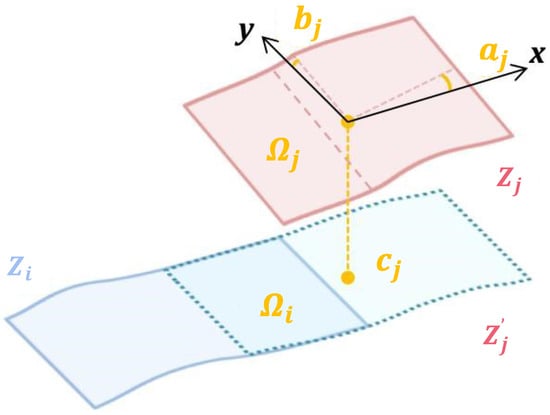
Figure 1.
Schematic of the principle of sub-aperture stitching.
Based on the calculated attitude adjustment parameters, the attitude of the sub-aperture j is adjusted to obtain the adjusted sub-aperture j at the ideal position. the height data of the adjusted sub-aperture j can be expressed as
Currently, depending on the different calculation methods for sub-aperture stitching angles, there are three primary strategies to choose from: sequential stitching, global stitching, and auxiliary stitching based on one-dimensional profile measurement. Each of these strategies has its own characteristics, with no clear advantage of one over the others. Each of these methods will be discussed below.
2.1.1. Sequential Stitching Method for Calculating the Stitching Angle
Sequential stitching is the most simple stitching strategy. When the sequential stitching method is adopted, the optimization objective for calculating the stitching angle of sub-apertures is to minimize the root mean square value of the residuals in the overlapping areas of two adjacent sub-apertures. In other words, it is to make the overlapping areas of adjacent sub-apertures as completely consistent as possible. This method can ensure the optimal matching of the overlapping areas of local adjacent sub-apertures, but it cannot guarantee the optimal matching of the overlapping area data of all sub-apertures. Furthermore, as the number of sub-apertures increases, the cumulative effect of stitching angle errors can become pronounced.
Suppose there are K data points in the overlapping area between two adjacent sub-apertures, the following formula can be listed to fit and calculate the attitude adjustment parameters of sub-aperture j:
where represents the position coordinate matrix of the data within the overlapping area of sub-aperture i and sub-aperture j, denotes the attitude adjustment parameter of the sub-aperture j to be solved, “≜” indicates that its two ends are equal in the sense of least squares, and is the residual data of the data within the overlapping area of sub-aperture i and sub-aperture j.
According to the principle of the least square method, the following formula can be listed to solve
2.1.2. Global Stitching Method for Calculating the Stitching Angle
Global stitching abandons the optimization direction of local optimum and instead opts to optimize the root mean square value of the residuals in the overlapping regions of all sub-apertures to the minimum to achieve global optimal matching. Due to the fact that errors in sub-aperture measurement results always exist, this method also cannot fundamentally overcome the cumulative effect of stitching angle errors. The global stitching algorithm attempts to calculate the adjustment parameters for all sub-apertures in a single step, involving a large amount of data and a relatively complex system of equations to solve. Assuming there are N + 1 sub-apertures, the adjustment parameters for the other sub-apertures are calculated using the first sub-aperture as the basement. The following formula represents the relationship among the residual data matrix, coordinate relationship matrix, and adjustment parameter matrix in the global optimization method.
In Equation (4), the specific expressions of each parameter are
where represents the number of data points in the overlapping area of sub-apertures i and j in a unified coordinate system after adding the position adjustment amount. x and y are vectors formed by the coordinates of the data in the overlapping area in the x and y directions in a certain order.
Equation (4) can be further simplified to Equation (8), which is represented by three large matrices.
By applying the least square method to solve f, the adjustment coefficient matrix P can be calculated, as shown in Equation (9).
2.1.3. Auxiliary Stitching Method Based on One-Dimensional Profile Measurement for Calculating the Stitching Angle
The auxiliary stitching based on one-dimensional profile measurement uses auxiliary equipment to measure the one-dimensional profile along the meridional centerline of the mirror surface, which is used to correct the stitching angle in the meridional direction of the sub-aperture. In this case, the optimization objective of the meridional stitching angle is to minimize the root mean square of the residuals between the interferometer measurement data and the one-dimensional profile data measured by auxiliary equipment, while the optimization objective of the sagittal stitching angle is to minimize the root mean square of the residuals between the data within the overlapping region of the sub-apertures. Since the stitching angle in the meridional direction is obtained by fitting one-dimensional profile data, this method does not have the problem of accumulation of stitching angle errors. The global accuracy of the obtained stitching result depends on the precision of the mirror profile data obtained by the one-dimensional profile measurement equipment. The solution process of the stitching angle is divided into two steps in the auxiliary stitching method. The following is a detailed introduction using LTP as a one-dimensional profile measurement device.
The first step is to align the one-dimensional profile data along the test mirror’s centerline, measured by the interferometer, with the LTP measurement results. This process yields the adjustment values for both the tilt angle in the meridional direction and height. Assuming that the length of each sub-aperture in the meridional direction corresponds to K pixels, the following formula can be listed:
where represents the x-coordinate of the K-th data point, is the adjustment parameter of the i-th sub-aperture, denotes the data on the midline of the two-dimensional Gaussian filtering result of the data measured by the interferometer for sub-aperture i, and represents the data on the midline measured by LTP corresponding to sub-aperture i.
The least squares fitting is carried out through the following formula to obtain .
The result of includes the meridional tilt angle adjustment amount and the height adjustment amount . At this point, adjustments can be made using only , or both and can be used for adjustments. The final stitching result will not show any difference, but the value of fitted in the second step of the following text will be different.
Step two involves calculating the residual data in the overlapping regions of adjacent sub-apertures, and then using this residual data for fitting to obtain the corresponding tilt adjustment in the sagittal direction and the height adjustment. Suppose there are K data points in the overlapping area of adjacent sub-apertures, the following formula can be listed:
where represents the y-coordinate of the K-th data point, represents the adjustment parameter of sub-aperture i relative to sub-aperture j, and represents the residual data of the data in the overlapping area between sub-aperture i and the sub-aperture j.
The parameter can be obtained through least squares fitting via the following equation.
The results of include the sagittal direction tilt angle adjustment amount and the height adjustment amount . By adjusting the attitude and position of each sub-aperture based on , all the interferometric sub-apertures can be placed in the ideal position and attitude.
2.2. Weighted Merging Method Based on Pixel Position for Merging the Data in the Overlapping Area
After adjusting the relative positions and attitudes of each sub-aperture based on the calculated stitching angles, the data from the overlapping regions of the sub-apertures must be merged. This process integrates the surface shape information from multiple local areas into a complete surface profile of the measured mirror region.
In this paper, we adopt a weighted merging method based on pixel position to merge the data in the overlapping area of sub-apertures. In the actual measurement process of sub-aperture data, it is often necessary to move the null-fringe in the sub-aperture interference fringe pattern to the central position of the sub-aperture to minimize the retrace error in the measurement results. In this case, since the null-fringe is located in the central region of the sub-aperture, the retrace error of the central region data of the measured sub-aperture data is smaller and the data credibility is higher. Therefore, a higher weight is assigned for central data during merging. Conversely, the retrace error of the measurement data in the edge region of the sub-aperture is relatively larger, the data credibility is lower, and the edge data is assigned a lower weight during merging. This method assigns weights to each pixel position in a progressive and continuous manner, which can completely eliminate the stitching traces. Additionally, by considering the error distribution characteristics of the measurement data, it can reduce the impact of measurement errors on the final surface shape stitching results.
Taking the overlapping area of sub-apertures A and B shown in Figure 2 as an example, any point is selected for analysis. The distance between this point and the boundary of sub-aperture A is , and the distance from the boundary of sub-aperture B is . represents the height data of this point obtained using the weighted merging method based on pixel position. can be obtained through the following formula.
where and represent the height data of sub-aperture A and sub-aperture B at point , respectively.
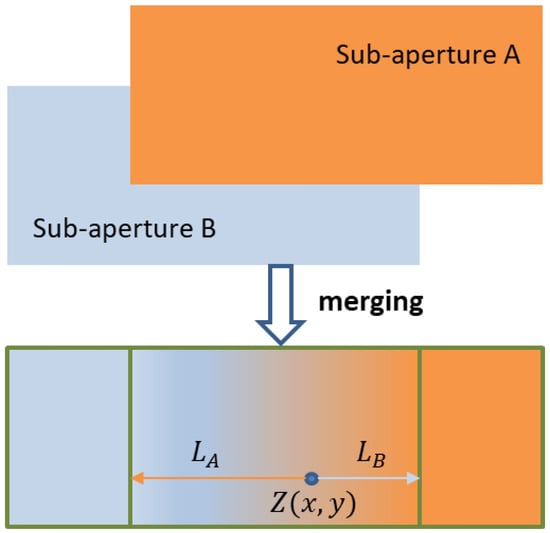
Figure 2.
Schematic of the merging process of the data in the overlapping area of sub-apertures.
3. Experiments and Results
3.1. Experimental Setup
In order to conveniently achieve the acquisition and stitching processing of sub-aperture data, the authors built a stitching interferometry measurement platform and developed an interferometric shape data processing software. The stitching interferometry measurement platform is used to scan the surface under test (SUT) to obtain the sub-aperture shape data, and the interferometric shape data processing software is used for environmental and system assessment before measurement and for stitching processing after sub-aperture data acquisition.
As shown in Figure 3, the stitching measurement platform consists of a Fizeau interferometer, a linear stage, and two rotating stages and . The interferometer (ZYGO verifire) features a CCD pixel size of 1024 pixels × 1024 pixels and is equipped with a 6-inch reference mirror with a surface quality better than /40. The linear stage is used to drive the mirror to translate along the meridional direction to achieve sub-aperture scanning, with a motion resolution of 0.2 μm within a 1000 mm stroke. Two rotating stages are used to adjust the relative attitude between the SUT and the interferometer reference mirror to ensure that each sub-aperture data is measured in a near null-fringe state. The resolution of is 1.2 μrad and the travel is ±2.5°. The resolution of is 1 μrad and the travel is ±4.5°. The interferometer and all moving mechanisms are fixed on an active vibration isolation marble table to reduce the influence of ground vibration during the measurement process. The photograph of the stitching interferometry measurement platform is shown in Figure 4.
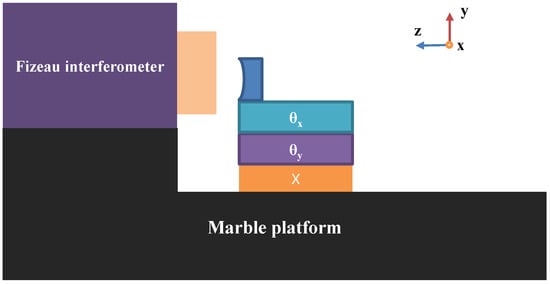
Figure 3.
Schematic of the stitching interferometry measurement platform.
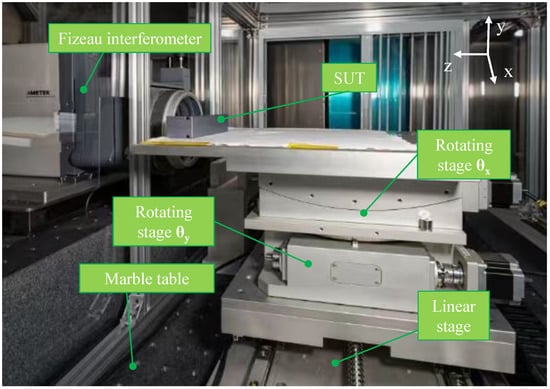
Figure 4.
Photograph of the stitching interferometry measurement platform.
The entire stitching interferometry platform is placed on an independent foundation and enclosed within a shelter made of thermal insulation material. All equipment is located in a constant temperature and humidity ISO Class 6 cleanroom, with the temperature set at 22 °C and humidity maintained at 45%. We conducted tests on the temperature stability and vibration conditions of the measurement environment. The results showed that the PV value of ambient temperature fluctuation over 12 h does not exceed 0.05 °C, with the vibration level of the marble table reached VC-F (horizontal) and VC-E (vertical). Such exceptional environmental conditions establish a solid foundation for improving the repeatability of our measurement results.
3.2. Operation Procedures for Mirror Measurement
A good measurement specification and strategy can help researchers obtain reliable data and greatly improve the efficiency of the measurement process. Taking the flat mirror as an example, the measurement process we adopted is formulated as shown in Figure 5. First, place the mirror on the measurement platform and roughly adjust the attitude of the mirror until the interference fringe pattern can be observed in the view window. At this point, the mirror to be measured is roughly parallel to the reference mirror. Let it stand for a period of time and wait for the environment to stabilize. Next, the rotating stage is controlled to precisely adjust the attitude of the mirror until the null-fringe appears at the center of the measurement area. A mask can be drawn to restrict a specific area of the measurement mirror surface, or the measurement result within the maximum measurable range can be obtained without drawing a mask. Next, the control software of the interferometer is operated for measurement to obtain the two-dimensional shape data of a local area on the mirror. Then, move the linear stage according to the pre-designed movement direction and step size to achieve the switching of the measurement sub-aperture. Due to the influence of the straightness error of the linear stage, the number of fringes in the field of view may increase after the movement is completed. To minimize the impact of the retrace error, the rotating stage needs to be operated to ensure that the null-fringe appear at the center of the measurement area after each movement of the linear stage. And then the surface shape data can be measured again. Repeat this process until all the sub-aperture shape data required are obtained. Finally, all the sub-aperture data can be stitched to obtain the final complete two-dimensional shape data.
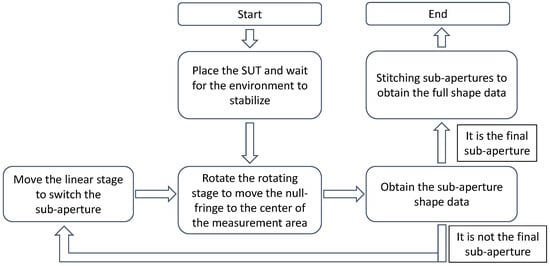
Figure 5.
The measurement process of stitching interferometry.
3.3. Data Processing Software for Interferometric Shape Height Data
In order to facilitate the processing of the measurement data obtained by the interferometer, we developed an interferometric shape data processing software named “QISS”. The name of this software is derived from the initials of the Qt-based image stitching software. Its main functional modules are shown in Figure 6. The primary function of QISS is to stitch sub-aperture data. Additionally, the software includes an evaluation module for interferometry systems, which comprises two components: stability assessment and repeatability assessment. This function helps evaluate the stability of the measurement environment and the reliability of the system’s results. The stitching module integrates three methods—sequential stitching, global stitching, and auxiliary stitching based on one-dimensional profile measurement—allowing users to easily select the appropriate method to achieve the desired stitching outcome.
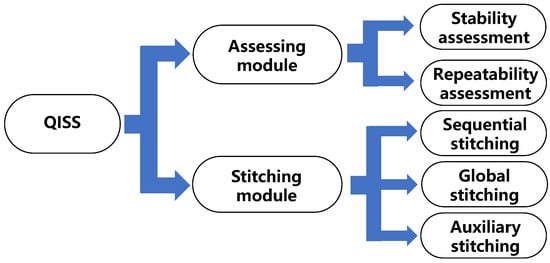
Figure 6.
Composition of the functional modules of QISS.
3.3.1. Performance Evaluation Module of QISS
Before performing sub-aperture scanning measurements with a stitching interferometer, it is necessary to wait for a period to allow both the environment and the mirror surface under test to stabilize. During this time, the stability assessment function within the evaluation module can be used to quantitatively evaluate the level of environmental interference affecting the system. Stability assessment evaluates the environmental conditions by analyzing the difference between two interferometric measurements taken a certain time apart. If the system’s environment has stabilized—for example, with minimal temperature fluctuations, very low airflow, and negligible vibration—the difference between the two measurements will be small and remain consistently so over time. In other words, when the difference between two temporally separated measurements is minimal and remains stable, it indicates that environmental conditions have settled. Typically, once the stability reaches a required threshold and remains consistent for a sustained period, the subsequent scanning and measurement process can be initiated.
In addition to the stability assessment, a repeatability assessment was also designed to evaluate the reliability of the system’s measurement results. After the external environment stabilizes, multiple measurement results of the same area to be measured are obtained in a short period of time, and the reliability of the system’s measurement results is evaluated by calculating the differences among these measurement results. If the measurement results of the system for the same measurement area vary greatly within a short period of time, we can consider that the reliability of the system’s measurement results is very weak. Conversely, if the differences among multiple measurement results of the same measurement area within a short period of time are very small, we can consider that the system’s measurement results are very reliable. The functional logic and interface display of the performance evaluation module are respectively shown in Figure 7 and Figure 8. Stability assessment needs to be conducted before each scan measurement, while repeatability assessment only needs to be carried out once for the same system.

Figure 7.
Functional logic of the performance evaluation module for the stitching measurement platform.

Figure 8.
The interface display of the system performance evaluation function of QISS.
In addition to stability assessment, a repeatability assessment has also been designed to evaluate the reliability of the system’s measurement results. Once the external environment has stabilized, multiple measurements of the same area are taken within a short time frame. The reliability of the system’s output is then assessed by analyzing the variations among these results. If the measurement results for the same area vary significantly over a short period, it indicates low reliability of the system’s measurements. Conversely, if the results remain consistent with only minor deviations, the system can be considered highly reliable. The functional logic and interface layout of the performance evaluation module are shown in Figure 7 and Figure 8, respectively. While stability assessment must be performed before each scanning measurement, repeatability assessment only needs to be conducted once for the same system.
In our laboratory, when assessing environmental stability, the interval between two consecutive data acquisitions is set at 90 s. The monitoring process typically lasts over two hours, with more than 80 results collected. The evaluation metric is derived by calculating the average of the RMS values of residuals between consecutive measurements. If the calculated stability value falls below 0.25 nm, we consider the system’s environment to have stabilized. For evaluating system repeatability, we generally perform 10 rapid measurements on the same mirror area to obtain 10 results. The repeatability metric is then defined as the average of the RMS values of the residuals between these measurements and the mean surface profile. It should be noted that these specific parameter configurations can be adjusted according to actual requirements. For instance, when testing large mirrors requiring extended measurement durations, we may increase the number of acquisitions during environmental stability assessment to prolong the monitoring period.
3.3.2. Sub-Aperture Stitching Module of QISS
When using the data stitching function, first select the folder containing all the sub-aperture data. The data files in the folder should be named according to their measurement order. Once the folder is selected, the program automatically calculates the number of sub-apertures based on the number of files. Next, set the two main parameters: movement style and scanning direction. The movement style offers two options: equal step size and variable step size. If equal step size is selected, enter a single value in the step size field. If variable step size is chosen, enter the specific step sizes between each pair of adjacent sub-apertures used during scanning. For scanning direction, there are two options: forward and reverse. Forward corresponds to scanning in the direction of increasing CCD pixel coordinates, while reverse indicates scanning in the direction of decreasing CCD pixel coordinates. The operation workflow and interface layout are consistent across different stitching functions. The operation interface of the stitching function is shown in Figure 9.

Figure 9.
The interface display of the sub-aperture stitching function of QISS.
After setting the parameters, click the “Calculate” button to begin data processing. The software performs efficiently in terms of computational speed—for example, with the largest dataset we have tested so far, consisting of 300 sub-aperture files (each about 0.5 MB), the stitching process takes only about 10 s. Once the computation is complete, the software interface will display the stitched two-dimensional surface profile, along with a one-dimensional profile along the centerline. The PV and RMS values of the stitched surface data are also shown. If the user wishes to export the two-dimensional surface data for further analysis, simply click the “Export” button and choose the desired save location.
3.4. Test of the Repeatability Performance of the Measurement Platform
In order to evaluate the repeatability performance of the system, we conducted multiple repeated measurements on a high-precision flat mirror within a short period of time after the system stabilized, and observed the consistency among these multiple measurement results. In the measurement, we used a measuring aperture of 120 mm × 30 mm to cover as much area as possible. Multiple rapid measurements were made on the same local area of the flat mirror. Ten surface height data were obtained, each of which is the average of 36 measurement results. The shape distribution of the 10 sub-aperture measurement results shown in Figure 10 demonstrates a high degree of consistency.

Figure 10.
Ten repeated measurements on the flat mirror show excellent repeatability performance.
Take the average shape of these 10 measurement results as a reference and then calculate the differences between these 10 results and the average shape. These differences can be used to measure the repeatability of the measurement results of the interferometric platform on the same measured surface. If the difference between each single measurement result and the average shape is very small, it indicates that the repeatability performance of the measurement platform is quite good. It was calculated that the average RMS value of the 10 residual shapes obtained by subtracting the average surface shape from the single measurement result was 0.084 nm, which indicates that the established measurement platform has excellent repeatability performance. To better demonstrate the measurement environment in which our system operated during the repeatability assessment experiments, we have provided a brief summary of all environmental conditions in Table 1.

Table 1.
A brief summary of all measurement conditions for conducting repeatability evaluation experiments.
To verify the system’s repeatability in stitching measurements, we conducted two repeated scanning and stitching measurements on this flat mirror. The stitching process utilized seven sub-apertures, each measuring 120 mm × 30 mm with an overlap ratio of 90%, covering a total mirror area of 180 mm × 30 mm. As shown in Figure 11, the shapes of the two measurements are highly similar, with the residual error between them having an RMS value of only 0.26 nm. This further confirms that the system can achieve stitching measurements with excellent repeatability.
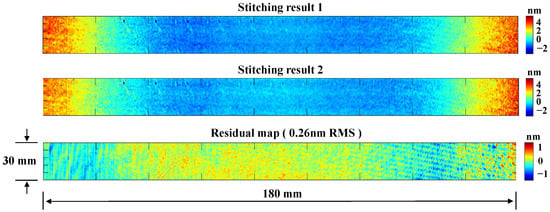
Figure 11.
The results of two repeated stitching measurements and the residual map between the two stitching measurement results.
3.5. Stitching Measurement of an Elliptical X-Ray Mirror with High Surface Quality
To verify the system’s capability for measuring complex curved surfaces, a stitching measurement was performed on a high-precision elliptical X-ray mirror. The mirror, manufactured by JTEC Corporation using the EEM polishing process, has overall dimensions of 400 mm × 50 mm × 50 mm and a clear aperture of 360 mm × 30 mm, as shown in Figure 12. It features exceptional surface quality, with a shape error of better than 3 nm (PV) and a slope error of better than 50 nrad (RMS). The nominal elliptic parameters are as follows: object distance P = 34.5 m, image distance Q = 9.5 m, and incident angle = 1°.
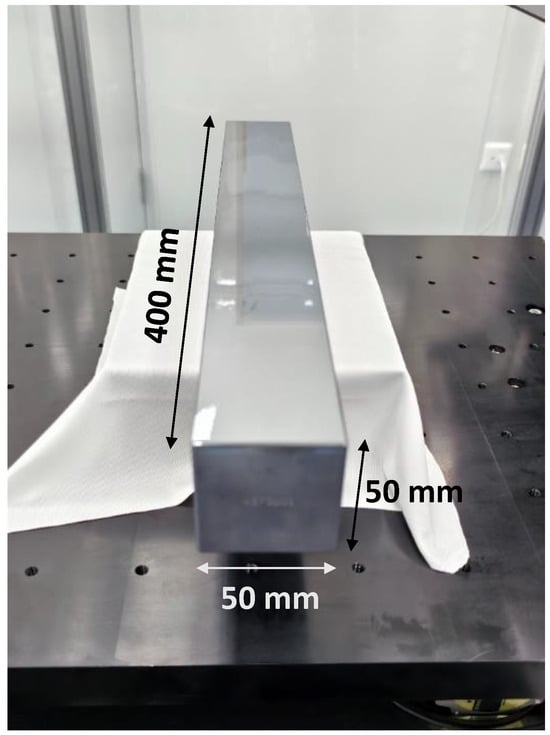
Figure 12.
A physical picture of the elliptical X-ray mirror to be tested.
Prior to the stitching measurement, a calibration of the interferometer’s reference mirror shape error was performed, which was subsequently removed from the measurement data during the scanning process. Additionally, the test mirror was allowed a sufficient stabilization period to ensure stability of both the measurement environment and the mirror surface. The lateral spatial resolution of the interferometer was determined through calibration to be 0.1512 mm/pixel. Sub-aperture scanning of the elliptical X-ray mirror was conducted using the established measurement system, employing a sub-aperture size of 60 mm × 28 mm. A total of 51 sub-apertures with a 90% overlap ratio were used to cover the measurement area of 360 mm × 28 mm. The obtained sub-aperture data was imported into the QISS software and processed using the sequential stitching algorithm. The final stitched result is presented in Figure 13.

Figure 13.
The stitching measurement result of the elliptical X-ray mirror.
The best elliptical cylindrical surface fitting was performed on the stitching measurement result. During the fitting process, the parameter P was fixed, and the best fitting results of the remaining parameters were obtained as Q = 9405 mm and = 0.9906°. The residual of the stitching result after deducting the best-fitting elliptical cylindrical surface is shown in Figure 14.

Figure 14.
The residual of the elliptical X-ray mirror stitching measurement result after deducting the best-fitting elliptical cylindrical surface.
The one-dimensional profile of the stitching measurement result was extracted and compared with the measurement data provided by JTEC Corporation, as shown in Figure 15. The results obtained by two different institutions through different methods have good consistency, which to some extent reflects that the built system can achieve high-precision measurement of the elliptical X-ray mirror. Minor deviations in the measurement results may be attributed to imperfections in the absolute calibration of the interferometer’s reference mirror and discrepancies in the actual measurement environment.

Figure 15.
Comparison of the centerline profile of the stitching measurement result of the elliptical X-ray mirror with the data provided by JTEC.
4. Discussion
The software we developed, QISS, is the first to integrate three commonly used stitching algorithms into a single platform. This greatly facilitates researchers in data processing, allowing them to easily compare results generated by different stitching algorithms and select the most suitable measurement strategy for their laboratory environment and existing conditions. Furthermore, the software innovatively implements a novel performance evaluation method for stitching interferometry systems and seamlessly integrates it with the stitching algorithms. This makes the software crucial for ensuring the reliable operation and efficient performance of stitching interferometer measurement systems.
In system repeatability tests, we achieved a single sub-aperture measurement repeatability of 0.084 nm RMS and a stitching measurement repeatability of 0.26 nm RMS. These results are highly encouraging as they not only validate the effectiveness of the series of measures we implemented for environmental control but also establish a solid foundation for the reliability of subsequent stitching measurements.
We used the developed system to measure a high-precision elliptical cylindrical mirror. The experimental results showed strong consistency with data provided by the manufacturer, JTEC Corporation. This further confirms the reliability and precision of our system’s measurement capabilities. High-precision measurement of complex curved X-ray mirrors has always been an important yet challenging research topic. The results we obtained not only enhance the X-ray mirror measurement capabilities of our laboratory but also provide valuable experimental parameters and experiences for other related institutions to reference and learn from.
5. Conclusions
This paper presents the algorithmic principles of stitching interferometry and introduces a custom-built stitching interferometry system. The system consists of a measurement platform and data processing software, enabling efficient stitching measurements of X-ray mirrors. A high-precision elliptical X-ray mirror was measured using this system, and the result was compared with reference data provided by JTEC Corporation. The measurements obtained by the two institutions using different methods show good agreement. The system effectively meets the requirements for acceptance testing and assembly adjustment of X-ray mirrors, while also providing valuable data feedback for deterministic processing.
Author Contributions
Conceptualization, Y.W. and S.Z.; validation, Y.W., Y.Z. and H.W.; investigation, Y.W., H.W., Y.H. and L.H.; data curation, Y.Z.; writing—original draft preparation, Y.W. and Y.Z.; writing—review and editing, S.Z. and X.D.; supervision, S.Z.; project administration, X.D.; funding acquisition, X.D. All authors have read and agreed to the published version of the manuscript.
Funding
This work is supported by National Key R&D Program of China (Grant No. 2023YFA1608602), China Postdoctoral Science Foundation (Grant No. 2024M753120), Fundamental Research Funds for the Central Universities (WK2310000126) and Hefei Advanced Light Facility—a major national science and technology infrastructure in China (2205-000000-04-01-877238).
Data Availability Statement
The data that support the findings of this study are available from the corresponding author upon reasonable request.
Conflicts of Interest
The authors declare no conflicts of interest.
Abbreviations
The following abbreviations are used in this manuscript:
| LTP | Long Trace Profiler |
| NOM | Nanometer Optical Component Measuring Machine |
| QISS | Qt-based Image Stitching Software |
| SUT | Surface Under Test |
References
- Li, M.; Wu, J.; Wu, Y.; Xu, Y.; Zhang, D.; Hong, Z.; Yang, F.; Wan, J. A review on the fabrication technology of X-ray reflector. Opto-Electron. Eng. 2020, 47, 200205. [Google Scholar]
- Takacs, P.Z.; Qian, S.; Colbert, J. Design of a long trace surface profiler. Proc. SPIE 1987, 749, 59–64. [Google Scholar]
- Irick, S.; McKinney, W.; Lunt, D.; Takacs, P. Using a straightness reference in obtaining more accurate surface profiles from a long trace profiler. Rev. Sci. Instrum. 1992, 63, 1436–1438. [Google Scholar] [CrossRef]
- Qian, S.; Jark, W.; Takacs, P.Z. The penta-prism ltp: A long-traceprofiler with stationary optical head and moving penta prisma. Rev. Sci. Instrum. 1995, 66, 2562–2569. [Google Scholar] [CrossRef]
- Siewert, F.; Noll, T.; Schlegel, T.; Zeschke, T.; Lammert, H. The nanometer optical component measuring machine: A new sub-nm topography measuring device for x-ray optics at bessy. AIP Conf. Proc. 2004, 705, 847–850. [Google Scholar]
- Siewert, F.; Lammert, H.; Noll, T.; Schlegel, T.; Zeschke, T.; Hänsel, T.; Nickel, A.; Schindler, A.; Grubert, B.; Schlewitt, C. Advanced metrology: An essential support for the surface finishing of high performance X-ray optics. Proc. SPIE 2005, 5921, 592101. [Google Scholar]
- Siewert, F.; Buchheim, J.; Zeschke, T.; Störmer, M.; Falkenberg, G.; Sankari, R. On the characterization of ultra-precise X-ray optical components: Advances and challenges in ex situ metrology. J. Synchrotron Radiat. 2014, 21, 968–975. [Google Scholar] [CrossRef]
- Yamauchi, K.; Yamamura, K.; Mimura, H.; Sano, Y.; Satio, A.; Ueno, K.; Endo, K.; Souvorov, A.; Yabashi, M.; Tamasaku, K.; et al. Microstitching interferometry for X-ray reflective optics. Rev. Sci. Instrum. 2003, 74, 2894–2898. [Google Scholar] [CrossRef]
- Mimura, H.; Yumoto, H.; Matsuyama, S.; Yamamura, K.; Sano, Y.; Ueno, K.; Endo, K.; Mori, Y.; Yabashi, M.; Tamasaku, K.; et al. Relative angle determinable stitching interferometry for hard X-ray reflective optics. Rev. Sci. Instrum. 2005, 76, 045102. [Google Scholar] [CrossRef]
- Ohashi, H.; Tsumura, T.; Okada, H.; Mimura, H.; Masunaga, T.; Senba, Y.; Goto, S.; Yamauchi, K.; Ishikawa, T. Microstitching interferometer and relative angle determinable stitching interferometer for half-meter-long X-ray mirror. Proc. SPIE 2007, 6704, 670405. [Google Scholar]
- Yumoto, H.; Minura, H.; Kimura, T.; Handa, S.; Matsuyama, S.; Sano, Y.; Yamauchi, K. Stitching interferometric metrology for steeply curved X-ray mirrors. Surf. Interface Anal. 2008, 40, 1023–1027. [Google Scholar] [CrossRef]
- Yumoto, H.; Mimura, H.; Handa, S.; Kimura, T.; Matsuyama, S.; Sano, Y.; Yabashi, M.; Nishino, Y.; Tamasaku, K.; Ishikawa, T.; et al. Stitching interferometric measurement system for hard X-ray nanofocusing mirrors. Nucl. Instrum. Methods Phys. Res. Sect. A 2009, 186, 012080. [Google Scholar] [CrossRef]
- Yumoto, H.; Mimura, H.; Handa, S.; Kimura, T.; Matsuyama, S.; Sano, Y.; Ohashi, H.; Yamauchi, K.; Ishikawa, T. Sitching-angle measurable microscopic-interferometer: Surface-figure metrology tool for X-ray nanofocusing mirrors with large curvature. Nucl. Instrum. Methods Phys. Res. Sect. A 2010, 616, 203–206. [Google Scholar] [CrossRef]
- Yumoto, H.; Koyama, T.; Matsuyama, S.; Yamauchi, K.; Ohashi, H. Stitching interferometry for ellipsoidal X-ray mirrors. Rev. Sci. Instrum. 2016, 87, 051905. [Google Scholar] [CrossRef]
- Rommeveaux, A.; Barrett, R. Micro-stitching interferometry at the ESRF. Nucl. Instrum. Methods Phys. Res. Sect. A 2010, 616, 183–187. [Google Scholar] [CrossRef]
- Vivo, A.; Lantelme, B.; Baker, R.; Barrett, R. Stitching methods at the European Synchrotron Radiation Facility (ESRF). Rev. Sci. Instrum. 2016, 87, 051908. [Google Scholar] [CrossRef]
- Vivo, A.; Barrett, R. Fizeau stitching at the European synchrotron Radiation Facility (ESRF). Proc. SPIE 2017, 10385, 149–157. [Google Scholar]
- Vivo, A.; Barrett, R.; Perrin, F. Stitching techniques for measuring X-ray synchrotron mirror topography. Rev. Sci. Instrum. 2019, 90, 021710. [Google Scholar] [CrossRef] [PubMed]
- Xue, J.; Huang, L.; Gao, B.; Kaznatcheev, K.; Idir, M. One-dimensional stitching interferometry assisted by a triple-beam interferometer. Opt. Express 2017, 25, 9393–9405. [Google Scholar]
- Huang, L.; Xue, J.; Gao, B.; Idir, M. One-dimensional angular-measurement-based stitching interferometry. Opt. Express 2018, 26, 9882–9892. [Google Scholar] [CrossRef] [PubMed]
- Huang, L.; Idir, M.; Zuo, C.; Wang, T.; Tayabaly, K.; Lippmann, E. Two-dimensional stitching interferometry based on tilt measurement. Opt. Express 2018, 26, 23278–23286. [Google Scholar] [CrossRef]
- Huang, L.; Nicolas, J.; Idir, M. Repeatability analysis of one-dimensional angular-measurement-based stitching interferometry. Opt. Express 2018, 26, 20192–20202. [Google Scholar] [CrossRef]
- Huang, L.; Wang, T.; Nicolas, J.; Vivo, A.; Polack, F.; Thomasset, M.; Zuo, C.; Tayabaly, K.; Kim, D.W.; Idir, M. Two-dimensional stitching interferometry for self-calibration of high-order additive systematic errors. Opt. Express 2019, 27, 26940–26956. [Google Scholar] [CrossRef] [PubMed]
- Huang, L.; Wang, T.; Tayabaly, K.; Kuhne, D.; Xu, W.; Xu, W.; Vescovi, M.; Idir, M. Stitching interferometry for synchrotron mirror metrology at National Synchrotron Light Source II(NSLS-II). Opt. Laser Eng. 2020, 124, 105795. [Google Scholar] [CrossRef]
- Shi, Y.; Xu, X.; Huang, Q.; Wang, H.; Li, A.; Zhang, L.; Wang, Z. Development of relative angle determinable stitching interferometry for high-accuracy X-ray focusing mirrors. Proc. SPIE 2017, 10385, 103850M. [Google Scholar]
- Wu, Q.; Huang, Q.; Yu, J.; Xu, X.; Qi, R.; Zhang, Z.; Wang, Z. Simulation and measurement of systematic errors of stitching interferometry for high precision X-ray mirrors with large radius of curvature. Appl. Opt. 2021, 60, 8694–8705. [Google Scholar] [CrossRef]
- Wu, Q.; Huang, Q.; Yu, J.; Zhu, Y.; Gu, W.; Sheng, P.; He, Y.; Luo, H.; Zhang, Z.; Wang, Z. Mixed stitching interferometry with correction from one-dimensional profile measurements for high-precision X-ray mirrors. Opt. Express 2023, 31, 16330–16347. [Google Scholar] [CrossRef] [PubMed]
- da Silva, M.B.; Alcock, S.G.; Nistea, I.-T.; Sawhney, K. A Fizeau interferometry stitching system to characterize X-ray mirrors with sub-nanometre errors. Opt. Laser Eng. 2023, 161, 107192. [Google Scholar] [CrossRef]
Disclaimer/Publisher’s Note: The statements, opinions and data contained in all publications are solely those of the individual author(s) and contributor(s) and not of MDPI and/or the editor(s). MDPI and/or the editor(s) disclaim responsibility for any injury to people or property resulting from any ideas, methods, instructions or products referred to in the content. |
© 2025 by the authors. Licensee MDPI, Basel, Switzerland. This article is an open access article distributed under the terms and conditions of the Creative Commons Attribution (CC BY) license (https://creativecommons.org/licenses/by/4.0/).